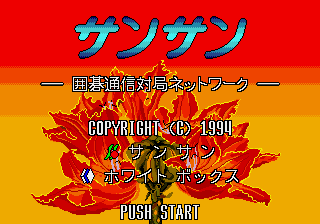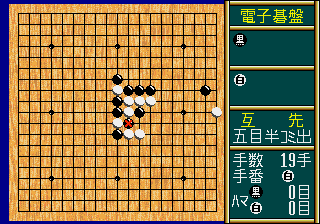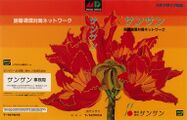Difference between revisions of "Sansan"
From Sega Retro
Scarred Sun (talk | contribs) |
|||
| (22 intermediate revisions by 11 users not shown) | |||
| Line 1: | Line 1: | ||
{{Bob | {{Bob | ||
| − | | bobscreen= | + | | bobscreen=Sansan title.png |
| − | | | + | | publisher={{company|[[Sansan (company)|Sansan]]}} |
| − | | | + | | developer={{company|[[White Box]]}} |
| − | | developer=White Box | ||
| system=[[Sega Mega Drive]] | | system=[[Sega Mega Drive]] | ||
| − | | | + | | sounddriver= |
| − | | peripherals=[[ | + | | peripherals=[[Mega Modem]] |
| players=1-2 | | players=1-2 | ||
| − | | genre= | + | | genre=Table |
| − | | | + | | releases={{releasesMD |
| + | | md_date_jp=1994-09{{ref|https://web.archive.org/web/20010311152520fw_/http://sansan.co.jp/company.html}} | ||
| + | | md_code_jp=T-147013 | ||
}} | }} | ||
| − | '''''[http://sansan.co.jp/ Sansan]''''' (サンサン) is an online service allowing people living in Japan to play the abstract strategy board game [[wikipedia:Go (game)|Go]] with other subscribers over the internet on a Windows PC. However, at its launch in 1994, a version for the [[Sega Mega Drive]] was also made available. This version of the game allows players who have a [[ | + | }} |
| + | '''''[http://sansan.co.jp/ Sansan]''''' (サンサン) is an online service allowing people living in Japan to play the abstract strategy board game [[wikipedia:Go (game)|Go]] with other subscribers over the internet on a Windows PC. However, at its launch in 1994, a version for the [[Sega Mega Drive]] was also made available. This version of the game allows players who have a [[Mega Modem]] to connect over a 33.3kbps or ISDN line to play other members who have a Sansan ID. However, as of 2011, there are no known Mega Drive-compatible Sansan servers. A local two-player version of the game is also included for play. | ||
| − | + | Due to the late release, the Mega Drive version did not last very long — it is one of the rarest and most sought-after Mega Drive games; [https://web.archive.org/web/*/http://sega.jp/fb/segahard/md/soft_licensee.html Sega of Japan's official archive doesn't list it] (despite Sansan Co., Ltd. having [[Third-Party T-Series Codes|T-series code]] T-147) and a ROM was not dumped until February 2011. The Windows PC version of the service continues to this day. | |
==Gameplay== | ==Gameplay== | ||
| − | [[File:Sansan gameplay.png| | + | [[File:Sansan gameplay.png|thumb|right|320px]] |
Two players, Black and White, take turns placing a stone (game piece) of their own color on a vacant point (intersection) of the grid on a Go board by pressing {{C}}. Black moves first. The official grid comprises 19×19 lines. Vertically and horizontally adjacent stones of the same color form a chain (also called a string) that shares its liberties (see below) in common, cannot subsequently be subdivided, and in effect becomes a single larger stone. Only stones connected to one another by the lines on the board create a chain; stones that are diagonally adjacent are not connected. Chains may be expanded by placing additional stones on adjacent intersections, and can be connected together by placing a stone on an intersection that is adjacent to two or more chains of the same color. | Two players, Black and White, take turns placing a stone (game piece) of their own color on a vacant point (intersection) of the grid on a Go board by pressing {{C}}. Black moves first. The official grid comprises 19×19 lines. Vertically and horizontally adjacent stones of the same color form a chain (also called a string) that shares its liberties (see below) in common, cannot subsequently be subdivided, and in effect becomes a single larger stone. Only stones connected to one another by the lines on the board create a chain; stones that are diagonally adjacent are not connected. Chains may be expanded by placing additional stones on adjacent intersections, and can be connected together by placing a stone on an intersection that is adjacent to two or more chains of the same color. | ||
A vacant point adjacent to a stone is called a liberty for that stone. Stones in a chain share their liberties. A chain of stones must have at least one liberty to remain on the board. When a chain is surrounded by opposing stones so that it has no liberties, it is captured and removed from the board. Players are not allowed to make a move that returns the game to a previous position. This rule, called the ko rule (from the Japanese 劫 kō "eon"), prevents unending repetition. Instead of placing a stone, a player may pass. This usually occurs when they believe no useful moves remain. When both players pass consecutively, the game ends and is then scored. | A vacant point adjacent to a stone is called a liberty for that stone. Stones in a chain share their liberties. A chain of stones must have at least one liberty to remain on the board. When a chain is surrounded by opposing stones so that it has no liberties, it is captured and removed from the board. Players are not allowed to make a move that returns the game to a previous position. This rule, called the ko rule (from the Japanese 劫 kō "eon"), prevents unending repetition. Instead of placing a stone, a player may pass. This usually occurs when they believe no useful moves remain. When both players pass consecutively, the game ends and is then scored. | ||
| − | ==Physical | + | ==Magazine articles== |
| + | {{mainArticle|{{PAGENAME}}/Magazine articles}} | ||
| + | |||
| + | ==Physical scans== | ||
| + | {{ratings|MD}} | ||
{{Scanbox | {{Scanbox | ||
| console=Mega Drive | | console=Mega Drive | ||
| region=JP | | region=JP | ||
| − | | | + | | cover=Sansan md jp cover.jpg |
| cart=Sansan cart.jpg | | cart=Sansan cart.jpg | ||
}} | }} | ||
| − | [ | + | ==Technical information== |
| − | + | {{mainArticle|{{PAGENAME}}/Technical information}} | |
| − | + | ||
| + | ==External links== | ||
| + | *[http://www.asahi-net.or.jp/~fa2k-smz/megax06.html Information (Japanese)] | ||
| + | |||
| + | ==References== | ||
| + | <references/> | ||
| + | |||
| + | {{SansanOmni}} | ||
Latest revision as of 12:30, 1 May 2023
| Sansan | ||||||||||
|---|---|---|---|---|---|---|---|---|---|---|
| System(s): Sega Mega Drive | ||||||||||
| Publisher: Sansan | ||||||||||
| Developer: White Box | ||||||||||
| Peripherals supported: Mega Modem | ||||||||||
| Genre: Table | ||||||||||
| Number of players: 1-2 | ||||||||||
|
Sansan (サンサン) is an online service allowing people living in Japan to play the abstract strategy board game Go with other subscribers over the internet on a Windows PC. However, at its launch in 1994, a version for the Sega Mega Drive was also made available. This version of the game allows players who have a Mega Modem to connect over a 33.3kbps or ISDN line to play other members who have a Sansan ID. However, as of 2011, there are no known Mega Drive-compatible Sansan servers. A local two-player version of the game is also included for play.
Due to the late release, the Mega Drive version did not last very long — it is one of the rarest and most sought-after Mega Drive games; Sega of Japan's official archive doesn't list it (despite Sansan Co., Ltd. having T-series code T-147) and a ROM was not dumped until February 2011. The Windows PC version of the service continues to this day.
Contents
Gameplay
Two players, Black and White, take turns placing a stone (game piece) of their own color on a vacant point (intersection) of the grid on a Go board by pressing ![]() . Black moves first. The official grid comprises 19×19 lines. Vertically and horizontally adjacent stones of the same color form a chain (also called a string) that shares its liberties (see below) in common, cannot subsequently be subdivided, and in effect becomes a single larger stone. Only stones connected to one another by the lines on the board create a chain; stones that are diagonally adjacent are not connected. Chains may be expanded by placing additional stones on adjacent intersections, and can be connected together by placing a stone on an intersection that is adjacent to two or more chains of the same color.
. Black moves first. The official grid comprises 19×19 lines. Vertically and horizontally adjacent stones of the same color form a chain (also called a string) that shares its liberties (see below) in common, cannot subsequently be subdivided, and in effect becomes a single larger stone. Only stones connected to one another by the lines on the board create a chain; stones that are diagonally adjacent are not connected. Chains may be expanded by placing additional stones on adjacent intersections, and can be connected together by placing a stone on an intersection that is adjacent to two or more chains of the same color.
A vacant point adjacent to a stone is called a liberty for that stone. Stones in a chain share their liberties. A chain of stones must have at least one liberty to remain on the board. When a chain is surrounded by opposing stones so that it has no liberties, it is captured and removed from the board. Players are not allowed to make a move that returns the game to a previous position. This rule, called the ko rule (from the Japanese 劫 kō "eon"), prevents unending repetition. Instead of placing a stone, a player may pass. This usually occurs when they believe no useful moves remain. When both players pass consecutively, the game ends and is then scored.
Magazine articles
- Main article: Sansan/Magazine articles.
Physical scans
| Sega Retro Average | ||||
|---|---|---|---|---|
|
| N/A | |
|---|---|
| Based on 0 reviews | |
Technical information
- Main article: Sansan/Technical information.
External links
References
- ↑ http://sansan.co.jp/company.html (Wayback Machine: 2001-03-11 15:25)
| Sansan | |
|---|---|
|
Main page | Magazine articles | Reception | Region coding | Technical information | |



